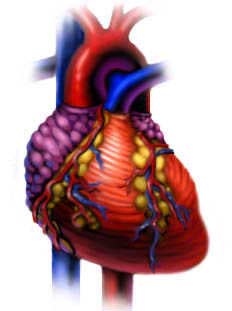The normal functioning of the heart can be affected when one of three components: the myocardium, heart valves, or cardiac nervous system is damaged. Damage to the cardiac nervous system disrupts the conduction impulses within the heart, leading to the chambers contracting out of sync.
 |
|
Heart Model (Photo: smm.org) |
Irregular blood flow in the heart results in blood pooling within the heart and inadequate supply to the circulatory system, causing arrhythmias.
Symptoms of Arrhythmias
Some arrhythmias may not cause any symptoms, however, most arrhythmias exhibit clear signs, including:
For rapid and irregular rhythms
Palpitations: A rapid or gradually increasing heartbeat.
Skipped beats: The heart may momentarily skip beats.
Shortness of breath – shallow breathing: Erratic heartbeats or many skipped beats may occur within a short period.
Other common symptoms: chest pain, dizziness, lightheadedness, persistent mild headaches.
Sudden rapid irregular heartbeats may indicate life-threatening ventricular fibrillation.
For slow rhythms
More subtle symptoms: Persistent fatigue, lightheadedness, mild headaches, and potential fainting. Many patients with arrhythmias may faint suddenly without prior warning signs. However, sometimes patients notice warning signs such as lightheadedness, dizziness; seeing halos; sweating; nausea or vomiting; bloating; palpitations; headaches; confusion or difficulty articulating thoughts.
Causes of Arrhythmias
Everyone has experienced moments of irregular heartbeats, but these episodes usually pass and do not impact daily life. However, some arrhythmias persist and can affect or endanger life, thus requiring timely diagnosis and treatment.
The causes of arrhythmias can be classified into congenital and acquired:
Congenital causes: The disease may manifest from childhood or arise at any stage of life.
Acquired causes: Conditions affecting the myocardium, heart valves, and other factors impacting the cardiac nervous system lead to abnormal activities within it.
Common Types of Arrhythmias
Supraventricular tachycardia may present symptoms such as:
Atrial Tachycardia: A focus of impulse generation emerges separate from the sinoatrial node in the atrium, producing impulses that overshadow those from the sinoatrial node, resulting in a very fast, irregular heartbeat.
Atrial Fibrillation: The atria contract chaotically and rapidly, exceeding 350 beats per minute, and cause the ventricles to contract quickly and irregularly. This type of arrhythmia can lead to other rhythm disturbances. Atrial fibrillation often results in chronic fatigue, congestive heart failure, and a five-fold higher risk of stroke compared to individuals without it.
Atrial Flutter: A condition where the atria beat very rapidly, reaching up to 300 beats per minute, causing the heart to beat very fast and irregularly.
Sinus Tachycardia: Sinus tachycardia often occurs during anxiety or exercise, returning to normal at rest. Conditions like high fever, anemia, or hyperthyroidism may also lead to sinus tachycardia, which normalizes with treatment.
Ventricular Tachycardia from Ventricular Fibrillation.
Tachyarrhythmias
Spontaneous ventricular tachycardia: Arises when a group of cells in the ventricle emits impulses that stimulate the ventricles to contract, resulting in irregular contractions with the atria.
Ventricular tachycardia due to ischemic heart disease: Areas of myocardium deprived of blood in coronary artery disease create scar tissue, which produces abnormal conduction pathways in the ventricle, stimulating ventricular contractions without impulses from the atria.
In both cases, the ventricles contract without adequate blood filling, leading to rapid heartbeats while failing to pump enough blood into the circulation. Patients often experience fatigue, difficulty concentrating, and rapid breathing. If not treated promptly, ventricular fibrillation may occur.
Bradyarrhythmias
When the heart rate drops below 60 beats per minute, there is a risk of insufficient blood supply to the circulation; however, athletes may naturally have a heart rate below 60 beats per minute.
Bradyarrhythmias may not present obvious symptoms, but the following may occur: fatigue, dizziness, lightheadedness, headaches, shallow breathing, or fainting.
Bradyarrhythmias are classified into two main types:
– Sick sinus syndrome: This is not a specific disease but represents a group of symptoms indicating that the sinoatrial node is not functioning normally. Heart rate may alternate between bradyarrhythmias and tachyarrhythmias.
– Atrioventricular block: This phenomenon occurs when impulses are obstructed as they travel from the atria to the ventricles.
Regarding treatment: Depending on the cause of the arrhythmia, treatments may include medication, cardiac interventions, or surgery. Regardless of the treatment method, patients should adopt healthy lifestyle habits, such as regular exercise, avoiding smoking, and maintaining a balanced diet and healthy living conditions.
How to Prevent Arrhythmias?
– Choose a healthy lifestyle: exercise regularly, consume less fat, eat more vegetables and foods rich in vitamins, and maintain a healthy weight.
– Avoid smoking.
– Limit consumption of heart stimulants such as coffee and alcohol.
– Avoid stress and ensure adequate rest time.
– Have regular health check-ups.
– Effectively manage related health conditions: atherosclerosis, high cholesterol, coronary artery disease, valvular heart disease, thyroid disorders…


















































